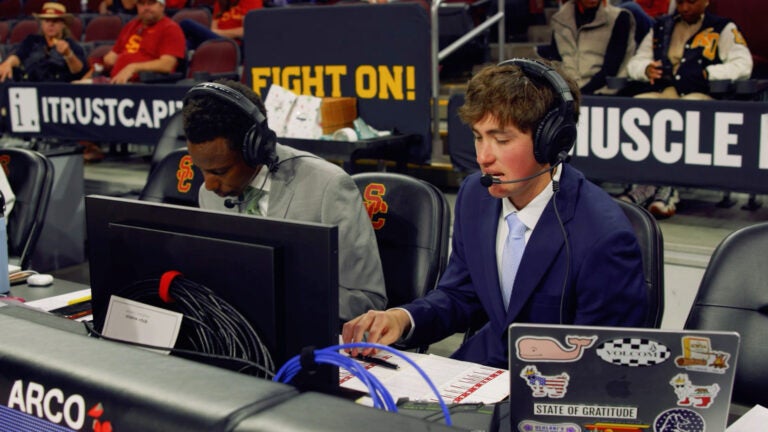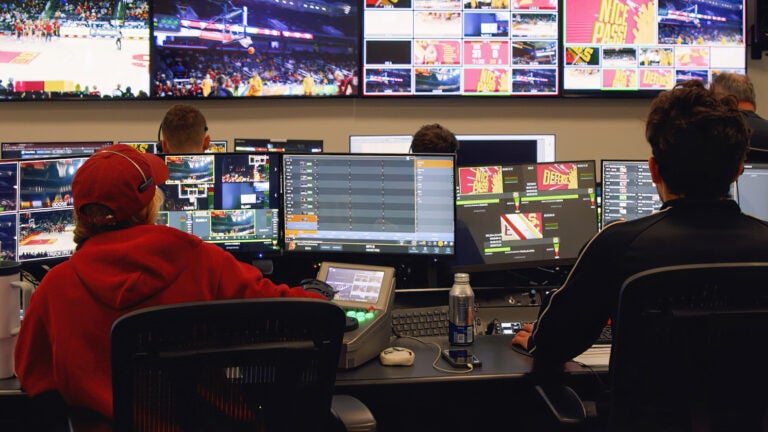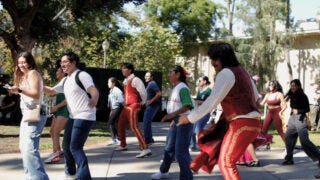
USC Dornsife student Andrew Giesler (right) is part of USC’s Big Ten Network StudentU program, a sports production program that streams more than 2,500 live events each year. (USC Photo/Sean Dube and Kris Head)
Big Ten Network StudentU program brings real-world sports-broadcasting opportunities to USC students
The organization produces more than 2,500 athletic events per year on the Big Ten Network’s streaming platform, B1G+.
Hours before cardinal-and-gold-clad basketball fans flood through the Galen Center doors, before the in-house DJ starts blasting the warmup music, and before the USC Women of Troy take the court for their pregame shooting routine, Andrew Giesler sits courtside in his navy blue suit and looks over his notes.
Giesler isn’t on the coaching staff, nor is he an athletics manager or USC student-athlete. But he is on a team — one that ensures that high-quality streams of USC athletic events reach homes across the country. The sophomore biological sciences major is part of the university’s Big Ten Network StudentU program, a sports production program that streams more than 2,500 live events each year.
On this Sunday afternoon in mid-December, Giesler provides color commentary for the USC women’s basketball game against Elon University. The game will be streamed exclusively on B1G+, the streaming service of the conference’s official cable network — the Big Ten Network.
“It’s just really cool to be able to pursue this passion of mine that I’ve always wanted to do, especially as a bio major,” said Giesler, a student in the USC Dornsife College of Letters, Arts and Sciences — and a lifelong sports fan who used to mute the TV to do his own play-by-play over games. “USC just goes for it — whether that’s athletically, academically or the opportunities it provides students — and the StudentU program showcases all of that.”
Bringing the Big Ten Network to USC

Started in 2008 to bring more broadcast attention to sports other than football and men’s basketball, the Big Ten Network StudentU program provides students with instruction and hands-on experience in every facet of game-day production. The students are paid for their work, and the programming is student-produced and livestreamed on B1G+, with select games rebroadcast on the Big Ten Network cable channel.
“People are watching this — teams are watching the broadcast, coaches are watching the broadcast and people who have families outside of SoCal are watching the broadcast,” said Avery Van Harte, a sophomore in the USC School of Cinematic Arts and a crew member on USC’s StudentU team. “When you stop and think about it, it’s so cool that the stuff that we’re doing is getting watched and being appreciated by people all over.”
Since the StudentU program started more than 15 years ago, the Big Ten Conference has undergone three separate expansions and added seven universities, including USC last year. Though the university is only in its first semester in the conference, USC is already making a name for itself athletically and in the realm of media production.
“Everything from the equipment the students are using to the space that they have in Galen Center is state-of-the-art,” said Rob Coons, director of the StudentU program at the Big Ten Network. “When students come through the program at USC, graduate and want to go get a job professionally, they’ll know how to use the exact same cameras, the exact same switchers and the exact same graphics system. They are prepared to go out in the world on day one, land a job and know what they’re doing.”
“When students come through the program at USC… they are prepared to go out in the world on day one and land a job and know what they’re doing.”
Rob Coons, director of the StudentU program at the Big Ten Network
Coons said the excitement for the StudentU program started well before USC was officially in the Big Ten Conference. In 2023, Coons and some of his colleagues visited USC to tour the University Park Campus and gauge interest in the program from students. His team set up a booth at the fall student involvement fair hoping to attract at least a dozen students. By the end of the fair, more than 70 students had stopped by the booth to get information.
“It was almost kind of overwhelming, but in a good way,” Coons said.
Currently, some 50 USC students work for the university’s StudentU program, which Coons said is more than what he expected for its first semester. But if the USC community was interested in the StudentU program, then the Big Ten Network was just as — if not more — interested in USC.
“I think just the prestige of USC Athletics and having that be part of the Big Ten is massive, combined with the prestige of the USC Annenberg School and all of the academics on campus,” Coons said. “You’re talking about adding a top-tier academic university into what was already arguably one of the best academic conferences in the entire country — it’s just elevating everyone’s experience in the Big Ten.”
Not only does USC bring its iconic programs including football, baseball and women’s basketball to the network, but it also brings sports programs such as water polo and beach volleyball to a Big Ten audience.
“One of the very first things I did when the announcement happened almost two years ago that UCLA and USC were going to join the Big Ten is I started looking at the roster of sports,” Coons said. “You guys have a beautiful venue for beach volleyball, and we’re really excited to showcase that.”
Gordon Stables, director of the School of Journalism at the USC Annenberg School for Communication and Journalism, says the control rooms at Galen Center help elevate USC’s brand as a sports journalism hub.
“We have a remarkable cinema school and obviously a lot of great journalism has been done here, but we were never really a sports media production campus,” Stables said. “Well, we are now.”
A student-run broadcast
The array of monitors and broadcast equipment in USC’s StudentU control room might be intimidating to some, but USC Annenberg senior Makena Arteaga saw only opportunity.
“The first time I walked in there my jaw literally just dropped,” Arteaga said. “Coming into that control room for the first time, I knew I wanted to spend as much time in there as possible.”
A Southern California native, Arteaga attended American University in Washington, D.C., for her first two years of college before transferring back home to USC. She said part of the appeal of becoming a Trojan was her passion for sports.
“During my time in D.C., I realized just how important sports culture was to me and being able to experience that at a professional level,” Arteaga said. “There are so many opportunities for USC students, not only being in L.A., but the school itself — we’re very athletically driven, which opens up a lot of opportunities to do things like the Big Ten StudentU.”
Originally, Arteaga wanted to do more on-air roles such as play-by-play, color and sideline reporting. But after hearing about an opening for a broadcast director, she decided to take a chance. Arteaga had no prior directing experience and said that her boss Alex Gomez — the assistant athletic director for broadcast operations at USC Athletics — took a chance on her. Gomez shadow-trained Arteaga on directing and had her shadow in the broadcast booth. Twenty-four hours later, she was off on her own, running a Big Ten broadcast.
“I remember studying what I had learned the night before for hours before my directorial debut, and just trying to get down the lingo, the tempo and everything that goes into running a good sports production,” Arteaga said.
That experience led to other opportunities, including on-air talent roles with ESPN+, where she provided color commentary for the USC women’s soccer team’s NCAA Tournament Elite 8 match.
Since Arteaga’s directorial debut, she has directed more than 20 broadcasts and found a new passion along the way.
“It’s been a role I didn’t expect to see myself in, but a role that I’ve fallen in love with,” Arteaga said.
Real-world experience
Unlike many of her her colleagues, Van Harte says she is not a huge sports fan, though she has had plenty of experience with sports video. She came into the StudentU program as a film student in the School of Cinematic Arts, but also as a former videographer for USC Athletics, where she made hype videos and social media content. Her colleagues at USC Athletics introduced her to the StudentU program, and she jumped at the opportunity to work behind the camera.
“A lot of the people who joined were more interested in the journalism side than the technical side,” Van Harte said. “I wanted to be in the control room from the get-go.” As a film student, she knows good cameras — when she first saw the equipment that USC’s StudentU program was working with, she was all in.
Though anyone involved with live sports could attest that there is no such thing as a perfect broadcast, everyone at USC’s StudentU program knows that the right resources and training can make a broadcast as close to perfect as possible.
Earlier this semester, Van Harte and some of her colleagues at StudentU toured the Intuit Dome in Inglewood, the brand-new home of the Los Angeles Clippers. Upon seeing the Intuit Dome’s control room, Van Harte said the setup felt very familiar, because it was the exact same equipment they have at Galen Center.
“Other places there might be a learning curve coming from a college program to a professional control center, but not here — we’re using the stuff that they actually use,” Van Harte said. “That moment made us all appreciate what we have a lot more and made us more invested and passionate in what we’re doing.”



